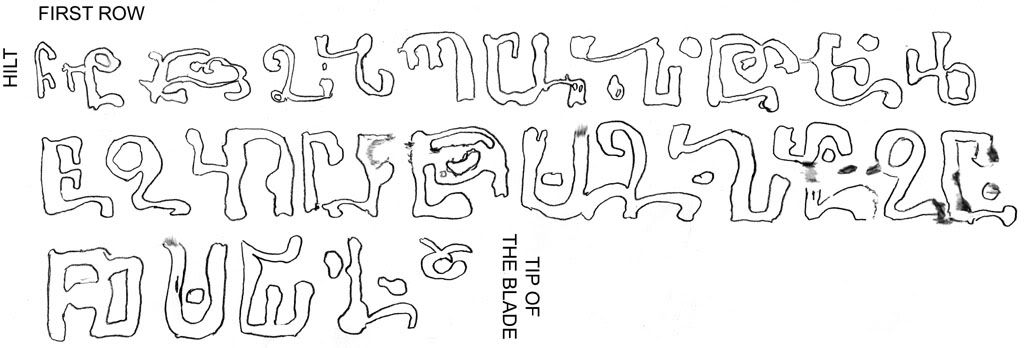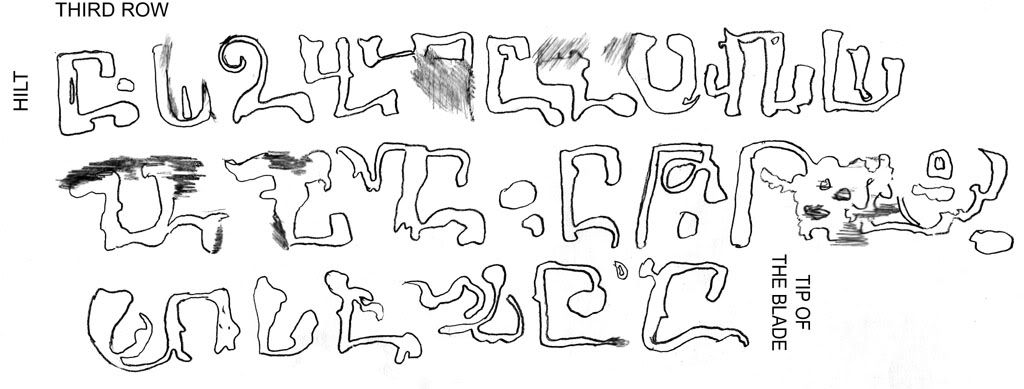
 |
|
|
|
|
#1 |
|
Member
Join Date: Dec 2004
Location: Poland, Krakow
Posts: 418
|
Hello all!
I have a question. On the pictures you can see a very huge sword - 110cm/43inch. long - it's bigger than sabre  The shape of the handle is like of Caucasian knives, the blade is quite solid, thick not cheap metal, but resilient, with fuller on both sides in the centre. On the blade are etched squiggles, and ornaments with letters or just pretending the letters (sorry no photo of this part). Main question is: do you think it's Caucasian or Persian - like some catalogues described it. I'm sure it's 19th century, maybe even 2nd half of the century. But what was the purpose of such huge weapon - only ceremonial? It is made very solidly, just like the weapon for use, but its size seems to be ridicoulus  . .I'm waiting for your opinions Thank you in advance and regards! |
|
|

|
|
|
#2 |
|
Member
Join Date: Dec 2004
Location: Ann Arbor, MI
Posts: 5,503
|
We usually attribute those to Persia and call them Qama, but I have never seen the "sword" -size one: at the most, they are large kindjals, up to 25inch total or thereabouts. This one is huge and obviously could not be used as a "kindjal", or secondary, sidearm. Should be looking elsewhere.
There is a semi-mythical Chechen sword, called Kaldan (with a crossguard, however) and there are swords with kindjal-type handles in Eastern Caucasian region (Daghestan, Chechnya). One is even illustrated in, I think, Askhabov' s book. I shall take pics. That is what I think it is. |
|
|

|
|
|
#3 |
|
Member
Join Date: Dec 2004
Posts: 655
|
Here is another monster that was sold by Artzi (43 inches). He identifies it as persian, and the engravings are quite typical persian work (I would guess ?).
I think it is somewhat similar to your sword. P.S. It would be really great to see the letters on your sword. |
|
|

|
|
|
#4 |
|
Member
Join Date: Dec 2004
Location: Poland, Krakow
Posts: 418
|
Thank you Ariel and Rivkin.
Indeed, the handle and the fuller of Artzi's piece are the same. I'll try to take a picture of these "letters" in a few days, but can't promise. It's good to hear you're tending to call it Persian. In one of the catalogues it was called "shamshir" - but I'm not convinced it's a proper name for such "monster"  Regards! |
|
|

|
|
|
#5 |
|
Member
Join Date: Jan 2005
Location: Haifa, Israel
Posts: 183
|
Hi all
An interesting sword indeed. In all our career we have examined three such swords, all of huge dimensions (we call it Qama to end all Qamas). 42-45 inches total length, 4-5 inches wide. One of these is posted above by Rivkin. The other one is shown below:  For more details on this sword see:Huge Qama Another similar sword is shown in Tirri’s book, page 206, Fig 143, shown next to a normal size kindjal and defined as Quadarra. In our opinion, these are Persian, Qajar period, second half of the 19C. In spite of the well forged steel, good sharp edges and good workmanship altogether these are ceremonial swords and not a fighting weapons. They are too big and cumbersome for battle use. We have heard several suggestions as execution swords, swords used in the Ashura celebrations of the Shiites etc. One more word on our sword posted by Rivkin: It was originally purchased in Jerusalem in 1918, wandered to the USA and returned to Israel. This gives a latest possible date for it. |
|
|

|
|
|
#6 |
|
Member
Join Date: Dec 2004
Location: Ann Arbor, MI
Posts: 5,503
|
Here it is, and it is, of course, from the Bible of Caucasian swords: Astvatsaturyan. It is a Khevsur Palasche. The handles on those were covered with brass, just like the regular Khevsur swords (on top). I guess, the swords under discussion in this thread are, indeed, Persian. The Khevsur ones were not ceremonial: these people were too poor to manufacture ceremonial weapons. The price of a sword labeled "David Ferrara " was 25 cows, the simple straight "pranguli" cost 10-12 cows and the simplest one, "rusuli", 2-3 cows. At prices like that nobody could afford a "toy" weapon.
|
|
|

|
|
|
#7 |
|
Member
Join Date: Dec 2004
Location: Poland, Krakow
Posts: 418
|
Well, it was real pain to take this pitures, so quality isn't the best. Here you can see etched blade. On one side something what could be letters, but it's hard to see on this pics, on the second side, just etched curled lines. On both side there is picture of "humanoid".
Regards! |
|
|

|
|
|
#8 |
|
Member
Join Date: Dec 2004
Posts: 655
|
Do you have a bigger resolution of the first picture ? The letters of two sides of a fuller are slightly reminding me of some caucasian alphabets (old georgian or even armenian).
|
|
|

|
|
|
#9 |
|
Member
Join Date: Dec 2004
Location: Poland, Krakow
Posts: 418
|
I'll try to take better picture tomorrow.
|
|
|

|
|
|
#10 |
|
Member
Join Date: Dec 2004
Location: Poland, Krakow
Posts: 418
|
I don't know if these picture will do, but let's make a try.I can upload bigger pics on photobucket if those posted below won't be enough.
One thing seems to be sure: these aren't Persian letters.  Thanks! |
|
|

|
|
|
#11 |
|
Member
Join Date: Dec 2004
Posts: 655
|
looks like very strange version of armenian to me. I will try to find out more.
|
|
|

|
|
|
#12 |
|
Member
Join Date: Dec 2004
Location: Poland, Krakow
Posts: 418
|
Great work and thank you very much Rivkin.
No, we don't know how it finds itself in Poland, it was purchased in 1962 without any knowledge about it. Second time, so all in all in two Polish catalogues of arms and armour, I found this sword is called SHAMSHIR  . Is this some misunderstanding or something, or do we really can call this huge, big and clumsy sword with the name od light, slick sabre? . Is this some misunderstanding or something, or do we really can call this huge, big and clumsy sword with the name od light, slick sabre?
|
|
|

|
|
|
#13 |
|
Member
Join Date: Dec 2004
Location: Poland, Krakow
Posts: 418
|
Hello!
I draw the letters from the blade. My skills aren't fabulous  but I hope it will do. Anyway now everything is readable (I hope). Some of the letters are damaged because of abrasion or acid. but I hope it will do. Anyway now everything is readable (I hope). Some of the letters are damaged because of abrasion or acid.    Regards! |
|
|

|
|
|
#14 |
|
Member
Join Date: Oct 2005
Posts: 68
|
I have a similar piece 34 inches---is the inlay possibley Armenian too?
|
|
|

|
|
|
#15 |
|
Member
Join Date: Jan 2006
Posts: 1
|
both swords are persian. the larger one is a persian heavy blade which dates back before shamshir became popular. persian swords were double edge heavy blades just like that one the only problem was that it was too difficult for persian immortals to weild them thats why shamshir took over. designed in the town of shamshir in current kermanshah of iran refering to lion's tale. the curve made it much stronger and easier on impact at the same time smaller and lighter. head on collision with a heavy blade became possible with introcution of shamshir so those blades became obselete. the carvings on the sword definitely are persian carving though they are armenian and seems like it has mix of kofi but i can't make any thing out of it. kofi is hard to read in perfect writing let alone in that condition. it seems as if someone built the sword in memory of something if it is truley a 19th century. as for the second sword is persion and the writings are more modern kofi its still missing dots so its not current arabic and its not as bad as the old kofi. there are different types of swords being built even today. shamshir isn't poplur in some regions, they still like to build the heavy double edged ones but none of them are practical. i have only seen a few double edge swords that were practical but definitely not as good as shamshir.
|
|
|

|
|
|
#16 |
|
Member
Join Date: Dec 2004
Posts: 655
|
Sorry wovliex - I have shown the writing to many armenians. They can read the letters (with an exception that the ones in the middle are most likely persian), but it has no apparent meaning. Astvatsaturjan wrote about unintelligeble armenian writings, and that seems to be one of them.
Any way, very rare thing - Qajar Kama with armenian signature, congratulations. |
|
|

|
|
|
#17 |
|
Member
Join Date: Dec 2004
Location: Poland, Krakow
Posts: 418
|
Thank you for your efforts. I almost forgot about that thread
 This sword will be presented soon on big exhibition in Gdansk/Danzig, Poland, called "Wonders of Orient". There should be quite nice arms and armor group, while one of the authors of this exhibition is tireless prof. Zygulski. All the best Michal |
|
|

|
 |
|
|